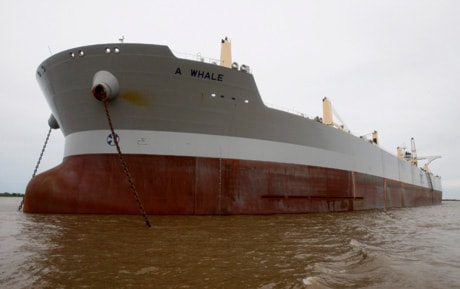NEW ORLEANS — The latest hopes are riding on a massive new skimmer to clean oil from near the spewing well in the Gulf of Mexico. A 48-hour test of the Taiwanese vessel dubbed “A Whale” began Saturday and was to continue through Sunday.
TMT Shipping created what is billed as the world’s largest oil skimmer by converting an oil tanker after the April 20 explosion sent millions of litres of crude spilling into the Gulf.
The vessel was expected to cruise a 65-square-kilometre test site just north of the Macondo Deepwater well site, company officials said.
The U.S. Coast Guard and British Petroleum are waiting to see if the vessel, which is 10 storeys high and as long as 3 1/2 football fields, can live up to its makers’ promise of being able to process up to 79 million litres of oil-fouled water a day.
The ship works by taking in water through 12 vents, separating the oil and pumping the cleaned seawater back into the Gulf.
“In many ways, the ship collects water like an actual whale and pumps internally like a human heart,” TMT spokesman Bob Grantham said in an email.
The skimmer is being tested close to the wellhead because officials believe it will be most effective where the oil is thickest rather than closer to shore.
The ship arrived in the Gulf on Wednesday, but officials have wanted to test its capability as well as have the federal Environmental Protection Agency sign off on the water it will pump back into the Gulf, which will contain trace amounts of crude.
The wait has frustrated some local officials, who say the mammoth skimmer would be a game-changer in keeping oil from reaching vulnerable coastlines.
During a Thursday tour of the inlet to Barataria Bay, Louisiana Gov. Bobby Jindal said it was exasperating to have the ship anchored offshore instead of being put to immediate use.
“They’ve used the war rhetoric,” Jindal said aboard a boat floating in oil-slicked waters near Grand Isle. “If this is really a war, they need to be using every resource that makes sense to fight this oil before it comes to our coast.”
The governor, who has been outspoken in his criticism of the relief effort, also criticized a decision by the U.S. Army Corps of Engineers to reject a proposal by Jefferson Parish to build a series of rock dikes to protect the ecologically important Barataria Bay.
Parish officials were using a fleet of barges — dubbed the “Cajun Navy” — as temporary barriers to block the oil, but some was still seeping in. The Corps found that the dike plan was incomplete, lacking a designated agency to remove the barriers, a restoration plan for environmental damage and data to measure any such damage.
Back at the well site, work continued through the weekend to prepare another vessel, the Helix Producer, to hook up to the containment cap at the seafloor and start collecting up to 25,000 barrels a day. The work was delayed by severe weather from Hurricane Alex.
If workers are able to hook up the Helix Producer this week, it could double the amount of oil being collected at the well head and then burned or transferred to other tankers.
Meanwhile, work is a few days ahead of schedule on two relief wells that BP says are the best chance at stopping the leak, BP America spokesman Daren Beaudo said.
But the company is sticking with its early-to-mid-August timeframe for completing the wells because of the uncertainties of hurricane season and the precision needed as the drills get deeper into the ocean floor.
